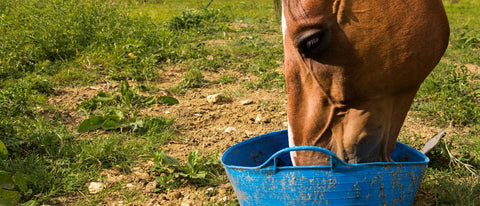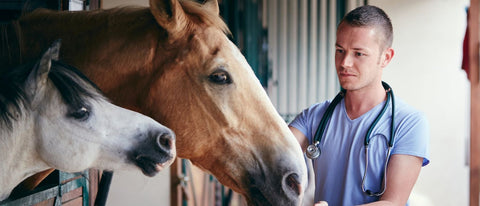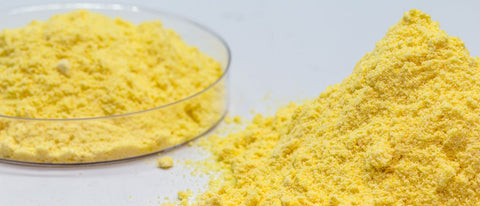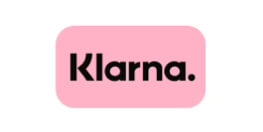
Florian ist aufgewachsen auf einem Bauernhof. Umgeben von Pferden, entdeckte er früh seine Faszination für diese majestätischen Tiere. Inspiriert von seiner reitbegeisterten Mutter, entwickelte er das Nahrungsergänzungmittel - Pferdegold. Seine tiefe Verbundenheit zur Natur und die leidenschaftliche Hingabe zu Pferden trieben ihn an, sein Unternehmen zu gründen.
Every horse owner knows how important proper nutrition is for our horses.
The Weender analysis offers a way to determine exactly which nutrients are contained in horse feed.
The method uses an analytical approach and breaks down the feed into its basic components, providing insight into the quality of the ingredients.
Of course, we also have our Pferdegold products subject to Weender analyses through our partners – you will find the analytical components listed on our products.
This way, you as a horse owner can make informed decisions about feeding and provide your horse with a balanced diet.
In this article, you will learn how the Weender feed analysis works and how it can help your horse achieve a balanced diet.
We'll show you why it's an essential part of feed management.
Discover how you can optimally care for your horse using scientific findings from the Weender Analysis.
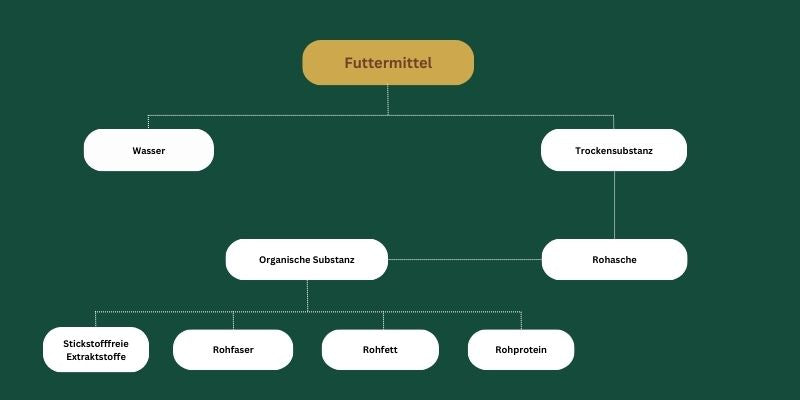
What is the Weender Analysis and why is it important?
The Weender analysis is an important method of feed analysis . It gives us detailed insight into what our horse is actually eating .
The Weender analysis is a method that breaks down the feed into its basic components – proteins, fats, fibers and more .
This makes it possible to determine exactly what is in the horse's feed and how the individual components can influence the health and performance of our horse.
Learn with us exactly how a Weender analysis works.

The Weender Feed Analysis Process: Step-by-Step Guide
The Weender feed analysis is a precise method for evaluating the quality of horse feed .
It allows you to understand the exact composition of the feed and to optimally adjust a horse's diet.
➽ Step 1: Determination of raw water
First, the fresh feed is freed from raw water by drying at 105 °C for about two hours to isolate the dry matter.
This phase is important and allows the amount of moisture in the feed to be determined.
➽ Step 2: Separation of the dry matter
The dry substance is then separated into its individual components at 500°C in order to isolate inorganic components (the so-called crude ash).
This is followed by a differentiation into salt-soluble pure ash (such as trace elements) and insoluble silicates (such as clay and sand).
Our product recommendation
➽ Step 3: Analysis of organic components
The organic components of the feed are then determined separately. Crude protein content is determined by nitrogen content , crude fat content by dissolving it in organic solvents such as hexane, and crude fiber content by treating the sample with acids and alkalis.
➽ Step 4: Determination of nitrogen-free extracts
The nitrogen-free extract content (NfE) is calculated at the end as the residual component after analysis of the other components.
What is behind the extended Weender analysis?
The extended Weender analysis improves the traditional feed analysis by providing an even more precise breakdown of feed components.
It distinguishes not only between cellular components such as crude protein , crude ash , crude fat , but also between more detailed elements such as non-structural carbohydrates , structural substances or other associated substances .
This analysis enables a differentiated assessment of the feed . The extended Weender analysis method thus provides specific and detailed information about feed composition. This can prove particularly valuable for specialized diets and for monitoring the health of horses with specific nutritional requirements.
Crude protein, crude fat, etc.: You should know these terms!
When it comes to your horse's nutrition, you've probably heard terms like crude protein, crude fat and crude fiber.
These components provide information about the nutritional composition of the feed . To ensure the best possible nutrition for your horse, it can be helpful to have a good understanding of these terms and their meaning.
What exactly is crude protein?
Crude protein is an essential nutrient in horse nutrition, vital for muscle building and tissue repair .
It is composed of various amino acids found in feed. Crude protein content is determined by analyzing the nitrogen content of the feed sample, as proteins contain nitrogen. The correct amount of crude protein in the feed supports your horse's health and performance.
What exactly is crude fat?
Crude fat refers to the portion of feed that dissolves in fat solvents such as hexane. It is an important source of energy and contributes to the absorption of fat-soluble vitamins .
The crude fat content in the feed should be carefully considered, as both a deficiency and an excess of fat can cause health problems .
What exactly is crude fiber?
Crude fiber is an indicator of the amount of dietary fiber in the feed , primarily cellulose. This indigestible fiber is important for the horse's intestinal health.
They promote digestion and ensure a long-lasting feeling of satiety . An adequate fiber content in the feed helps prevent digestive problems such as colic.

Pferdegold® feeding bowl with lid
Our cereal bowl is perfect for storing mash, muesli, and other treats—and thanks to its black plastic and golden Pferdegold logo, it also looks truly classy!
Order nowWhat exactly is crude ash?
Crude ash in feed indicates the mineral content and is therefore a measure of the total amount of minerals such as calcium and phosphorus. These are essential for bone health and many bodily functions . A balanced crude ash composition is important for the horse's health and performance.
Nitrogen-free extract substances – sugar, starch, etc.
Nitrogen-free extractives include components such as sugar and starch. They are significant energy sources and play an important role in the nutrition of horses.
A balanced supply of these substances is important to maintain the horse's energy requirements.
Raw water and dry matter
Raw water refers to the water content in the feed, while dry matter represents the solid components . Determining dry matter is important for calculating the actual nutrient density of the feed and adjusting feeding accordingly.
Additional tests for feed analysis
In addition to the standard Weender analysis , there are additional tests that provide deeper insights into the quality and safety of horse feed.
These tests are crucial to ensure a comprehensive assessment of the feed and to minimize potential risks to the horses' health.
Microbiological examination
The goal of a microbiological examination is to check the microbial quality of the feed . The feed is tested for pathogenic germs such as bacteria , fungi , and yeasts .
Such analysis is important to ensure the safety of feed and reduce the risk of diseases that could be transmitted through contaminated feed.

Molecular biological examination
Molecular biological testing aims to analyze genetic information in feed . This allows, for example, the identification of genetically modified organisms (GMOs) or specific DNA sequences . These tests are important for verifying the purity and authenticity of feed and for meeting regulatory requirements.
Chemical analysis
The goal of a chemical analysis is to determine the chemical composition of the feed. It analyzes ingredients such as vitamins, minerals, toxins, and heavy metals . This information is essential for assessing the nutritional balance and ensuring that the feed is free of harmful substances.
Residue analysis
Residue analysis focuses on the identification and quantification of residues such as pesticides , antibiotics , or hormones in feed . The goal of this analysis is to ensure feed safety and verify compliance with legal limits . Residue analysis is crucial for minimizing potential health risks for horses and other animals.
These legal bases apply to feed analysis
Feed analysis must comply with strict legal requirements. These include compliance with safety and quality standards stipulated by national and international laws. The goal is to protect the health of animals and, ultimately, humans.
The regulations include limit values for harmful substances, guidelines for the labeling and declaration of ingredients, and specifications for conducting tests.
Compliance with these legal frameworks is essential for all animal feed manufacturers.
How does the analysis of hemp-containing horse feed work?
The analysis of hemp-based horse feed focuses on the specific properties and ingredients of hemp. Particular attention is paid to the content of cannabinoids such as CBD and THC . The analysis includes checking the concentration of these substances to ensure they are within the legally permitted limits.
Additionally, standard parameters such as nutrient content and the presence of potential contaminants are examined. Hemp-based feed is becoming increasingly popular due to its potential health benefits for horses, but requires careful analysis to ensure safety and efficacy.

Pferdegold® feeding bowl with lid
Our cereal bowl is perfect for storing mash, muesli, and other treats—and thanks to its black plastic and golden Pferdegold logo, it also looks truly classy!
Order nowDeceptive ingredient information: The strategies of feed manufacturers
Pet food manufacturers are required to provide accurate information about the ingredients in their products. Ingredients are often listed in descending order of quantity, but this information can be misleading.
For example, in the case of organic magnesium compounds, the percentages stated may conceal the actual content of pure magnesium .
This potentially misleads consumers because the information does not reflect the quality or total nutrient content of the food, but only the amounts added.
High-quality & innovative horse feed at Pferdegold®
Pferdegold® stands for high-quality and innovative supplementary feeds that promote the well-being and vitality of horses. With a range of products that extend from respiratory support to muscular support , Pferdegold places great emphasis on the quality of its ingredients, many of which are derived from natural sources.
Pferdegold also offers a flexible subscription model , which is a convenient and cost-effective option for horse owners .
The focus on transparency , honesty and trust makes Pferdegold a reliable partner for horse owners who are looking for the best for their animals.
Conclusion
In the complex world of equine nutrition, the Weender Analysis offers a clear and informed way to understand and meet our horses' nutritional needs. This method allows us to analyze the feed down to the smallest detail and ensure our horses receive all the necessary nutrients.
Knowing and understanding the Weender Analysis can help every responsible horse owner optimize their horse's nutrition. The Weender Feed Analysis allows us to monitor the quality of the feed and thus sustainably protect and support the health and well-being of our horses.
FAQ
Where can I have a Weender analysis performed?
You can have a Weender analysis performed in specialized laboratories specializing in feed analysis. These laboratories are technically well-equipped and offer a comprehensive range of analyses.
It is recommended to use experienced laboratories that are familiar with the specific requirements of feed analysis. The selection of the laboratory should also be based on recommendations, certifications, and previous experience to obtain reliable and accurate results.
How long does a feed analysis take?
The duration of a feed analysis depends on various factors. A standard Weender analysis can be completed within a few business days, while more comprehensive tests, such as the extended Weender analysis or additional microbiological tests, may take longer.
The exact duration depends on the type of analysis, the complexity of the samples, and the laboratory's workload. It is advisable to discuss this with the laboratory in advance and plan for possible waiting times.
Learn more about the world of horses and read our next guides!
- Feeding horses optimally and naturally » That's what matters!
- Feeding a thin horse » 13 expert tips at a glance
